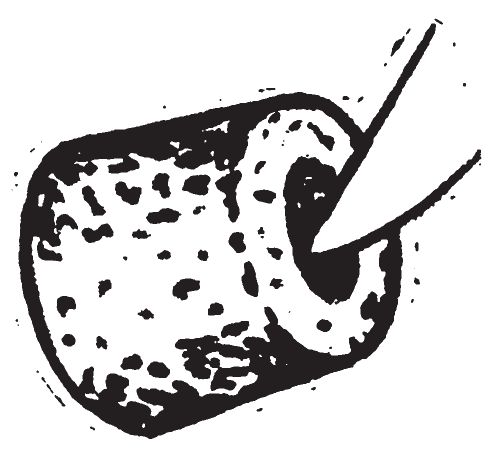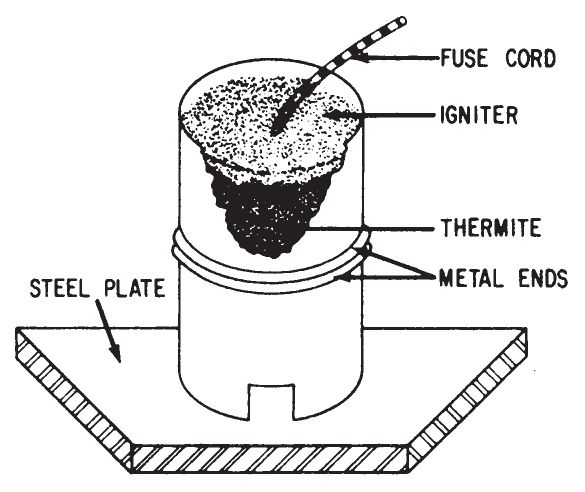U.S. Army Special Forces Guide to Unconventional Warfare (8 page)
Read U.S. Army Special Forces Guide to Unconventional Warfare Online
Authors: Department of the Army

a. Description.

- This item consists of a bottle of gasoline and concentrated sulfuric acid which is ignited by the chemical reaction of the acid with Sugar-Chlorate Igniter (0201). A delay feature is incorporated in this incendiary. The amount of delay is determined by time it takes the sulfuric acid to corrode a rubber membrane and react with the igniter mix. Immediate ignition may also be achieved by breaking the bottle and allowing the ingredients to mix.
- Prepared fire bottles are stored upright. This allows the heavier acid to lay on the bottom, with the gasoline on top. When put in use, the bottle is inverted, allowing the acid to come in contact with the rubber membrane and to begin corroding it.
b. Material and Equipment.
Wide mouth bottle.
Cork or rubber stopper (must fit snugly in bottle).
Sheet rubber on rubber membrane.
Sugar-Chlorate Igniter (0201).
Concentrated Sulfuric Acid (0103).
Gasoline.
c. Preparation.
- Cut or drill a cavity on the bottom of the cork big enough to hold at least two teaspoonfuls of sugar-chlorate igniter. Be careful not to break through the cork. If the hole does go all the way through, it must be sealed with another smaller cork.

- Fill the bottle with a 50/50 concentration of gasoline and sulfuric acid. Pour the gasoline in first, then add the sulfuric acid carefully, making certain not to splash acid on the skin or in the eyes.
Note
. If only battery grade sulfuric acid is available it must be concentrated before it can be used. See paragraph 0103 for details of concentration process. - Fill the hole in the cork with Sugar-Chlorate Igniter (0201). Cover the side of the cork containing the igniter with a piece of thin rubber membrane and then force the cork into the gasoline-acid filled bottle. Take care to prevent any of the igniter mix from falling into the jar.
d. Alternate Method of Preparation.
- Drill or cut a hole all the way through the cork.
- Fill the bottle with gasoline and acid as described above.
- Place the rubber membrane over the cork and install in the bottle. Make certain that cork is fitted tightly and rubber membrane fully covers the inner portion of the bottle.
- Fill the hole in the cork with igniter mixture as before and install a small cork in the hole covering the igniter mixture.
e. Application.
- To start the delay working invert the bottle. The acid will begin corroding the rubber membrane. When the acid breaks through, it will react violently and either break the bottle or blow out the cork stopper and ignite the gasoline.
- The Delay Fire Bottle works well on readily ignited materials where the scattering of the burning gasoline will start a number of fires at once. To ignite wooden structures, preparation such as piling up of flammable tinder and kindling is required.
- The delay time for initiation of the gasoline is slowed down in cold weather and may be stopped if the acid freezes. Check the delay time by testing the acid with the identical thickness rubber membrane at the temperature of expected use. Always use concentrated sulfuric acid.
a. Description.
- Thermite is composed of magnetic iron flakes and aluminum powder. Thermite may be obtained as a manufactured item or may be improvised for use in welding machinery parts together and burning holes in metal structures. The termite reaction is initiated Ly strong heat and therefore cannot be directly ignited with a safety fuse or match. The following igniters, found in chapter 3, may be used to initiate thermite: Powdered AluminumâSulfur Pellets (0207), Magnesium PowderâBarium Peroxide Igniter (0210), and Subigniter for Thermite (0211).
- Thermite is very safe to handle and transport because of its high ignition temperature. It burns well in cold and windy weather. Thermite will penetrate a sealed metal container and ignite the contents. It may be easily improvised if aluminum powder and iron oxide particles of the proper size are available.
b. Material and Equipment.
Aluminum powder (no coarser than ground coffee).
Iron oxide flakes (Fe
3
O
4
âsimilar to coarse ground coffee).
Spoon or cup for measuring.
Jar or can with tight fitting lid.
Cardboard can with metal ends.
c. Preparation.
- Place three parts by volume of iron oxide and two parts by volume of aluminum powder into the jar. Leave enough empty space to facilitiate mixing.
- Tighten the lid on the jar, turn the jar on its side and slowly roll until the two powders are completely mixed. The mixture is now ready for use and may be stored for months in the sealed container.
d. Application.
- Thermite is used to attack metallic targets such as transformers, electric motors, file cabinets, gears, bearings, boilers, storage tanks and pipelines. In operation, the methods described below produce a quantity of molten metal that streams out the bottom of the unit. On contact with the target, the molten metal will cut through the outer metal casing and pour molten metal on the interior. Thermite is not recommended for use on moderate or heavy wouden structures or other applications where a persistent flame is required. Two basic techniques are described, one for burning holes in steel and the other for welding steel parts together.
- (a)
Burning holes.- . In order to penetrate a steel plate with the minimum quantity of thermite, the mass of ignited thermite must be held away from the target during the initial combustion period. This minimizes conductive heat loss (from the thermite to the target) during this period and results in the thermite attaining maximum combustion temperature. When that temperature is reached, the thermite is dropped onto the steel plate surface and a hole is burned through the plate. The following illustrates the method for burning a hole through a plate of â
inch structural steel.
- . Cut a cardboard can (having metal ends) into two equal sections. Example of the type of cardboard container required are which contain household abrasive cleaners such as
AJAX, BON AMI
and
OLD DUTCH CLEANSER. - . One section of the can trimmed to a height of 2 inches and two side vents are cut as shown below.

- . The other section is filled approximately â
full with thermite. The thermite is then completely covered with one of the three above mentioned igniter materials to a depth of at least ¼ inch. Place the end of a length of Fuse Cord (0101) into the igniter mix, making certain that it does not extend into the thermite itself but ends in the center of the igniter mixture. Improvised String Fuse (0102) may be substituted for the Fuse Cord (0101) if desired.
- . The final assembly is constructed by placing the vented section, open face down, over the target area. The metallic end of this section is now facing up, away from the target surface. The section filled with thermite, igniter, and fuse is placed on top of the vented section. Both metal ends of the cardboard can are now touching.

- . After ignition, the thermite burns a hole through the steel plate dropping extremely hot particles of molten slag into the interior of the steel container. The side vents cut in the bottom section of the can allow excess slag to run off and not close up the hole in the steel target.
- . In order to penetrate a steel plate with the minimum quantity of thermite, the mass of ignited thermite must be held away from the target during the initial combustion period. This minimizes conductive heat loss (from the thermite to the target) during this period and results in the thermite attaining maximum combustion temperature. When that temperature is reached, the thermite is dropped onto the steel plate surface and a hole is burned through the plate. The following illustrates the method for burning a hole through a plate of â
inch structural steel.
- (
b
)
Welding.- A different method is employed when thermite is used to weld machinery components or plates together. The procedure is similar to that used for burning through steel except that the bottom stand-off is eliminated and the amount of thermite can be less than that used to burn through a â
inch steel plate. The assembly is shown below.

- In this instance, heat is conducted from the thermite to the steel during the combustion period. Thus, the steel is heated to nearly the same temperature as the slag and a weld is effectively made.
Caution:
Never attempt to ignite thermite without at least a few seconds delay time because it burns so quickly and so hot that the user could be seriously burned if he were nearby when ignition took place.
- A different method is employed when thermite is used to weld machinery components or plates together. The procedure is similar to that used for burning through steel except that the bottom stand-off is eliminated and the amount of thermite can be less than that used to burn through a â
inch steel plate. The assembly is shown below.
- (a)
a
.
Description
. Flammable liquids are an excellent incendiary for starting fires with easily combustible material. They burn with a hot flame and have many uses as incendiaries. Most of these liquids are readily available and they are easily ignited with a match. However, these liquids tend to flow off the target and their characteristic odor may cast suspicion on the person found carrying them.
b. Material and Equipment.
Can or bottle with tight fitting lid (minimum 1 pint capacity).
One of the following volatile liquids:
| Gasoline | Cleaners naptha |
| Kerosene | Turpentine |
| Toluene or Toluol | Lighter fluid |
| Xylene or Xylol | Fuel oil |
| Benzene or Benzol | Alcohol |
c
.
Preparation
. No preparation other than placing the liquid into an air-tight container for storage and transportation to the target is required.
d. Application.
The most effective way to use flammable liquids is to pour at least a pint of the liquid on a pile of rags or sawdust which have been place in a corner of a packing box or other wooden object. This procedure keeps the liquid concentrated in a small area and gives a more persistent flame for igniting wooden objects. If small pieces of charcoal are available, they should be soaked with the flammable liquid and placed on the target. The charcoal will ignite and give a hot, persistent glow that is long lasting. After placing the flammable liquid on the target, throw a lighted match on a soaked area. Do not stand too close when this is done.
